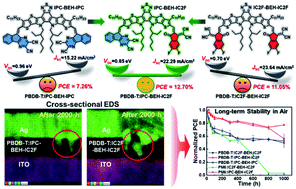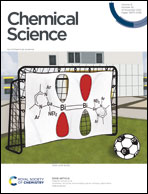Impact of symmetry-breaking of non-fullerene acceptors for efficient and stable organic solar cells†
Abstract
The concurrent enhancement of short-circuit current (JSC) and open-circuit voltage (VOC) is a key problem in the preparation of efficient organic solar cells (OSCs). In this paper, we report efficient and stable OSCs based on an asymmetric non-fullerene acceptor (NFA) IPC-BEH-IC2F. The NFA consists of a weak electron-donor core dithienothiophen[3,2-b]-pyrrolobenzothiadiazole (BEH) and two kinds of strong electron-acceptor (A) units [9H-indeno[1,2-b]pyrazine-2,3-dicarbonitrile (IPC) with a tricyclic fused system and 2-(5,6-difluoro-3-oxo-2,3-dihydro-1H-inden-1-ylidene)malononitrile (IC2F)]. For comparison, the symmetric NFAs IPC-BEH-IPC and IC2F-BEH-IC2F were characterised. The kind of flanking A unit significantly affects the light absorption features and electronic structures of the NFAs. The asymmetric IPC-BEH-IC2F has the highest extinction coefficient among the three NFAs owing to its strong dipole moment and highly crystalline feature. Its highest occupied molecular orbital (HOMO) and lowest unoccupied molecular orbital (LUMO) levels lie between those of the IPC-BEH-IPC and IC2F-BEH-IC2F molecules. The IPC group also promotes molecular packing through the tricyclic π-conjugated system and achieves increased crystallinity compared to that of the IC2F group. Inverted-type photovoltaic devices based on p-type polymer:NFA blends with PBDB-T and PM6 polymers as p-type polymers were fabricated. Among all these devices, the PBDB-T:IPC-BEH-IC2F blend device displayed the best photovoltaic properties because the IPC unit provides balanced electronic and morphological characteristics. More importantly, the PBDB-T:IPC-BEH-IC2F-based device exhibited the best long-term stability owing to the strongly interacting IPC moiety and the densely packed PBDB-T:IPC-BEH-IC2F film. These results demonstrate that asymmetric structural modifications of NFAs are an effective way for simultaneously improving the photovoltaic performance and stability of OSCs.

- This article is part of the themed collection: 2021 Chemical Science HOT Article Collection


 Please wait while we load your content...
Please wait while we load your content...